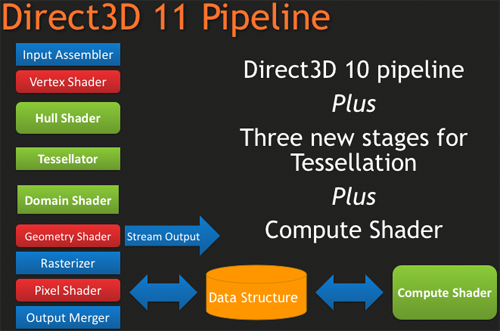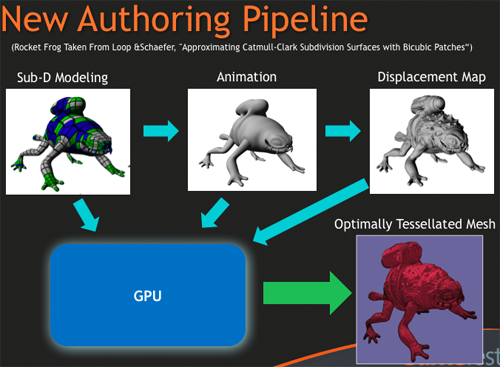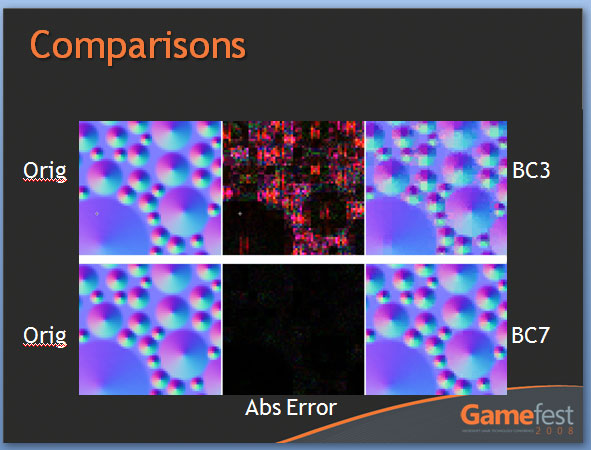AMD's Radeon HD 5870: Bringing About the Next Generation Of GPUs
by Ryan Smith on September 23, 2009 9:00 AM EST- Posted in
- GPUs
DirectX11 Redux
With the launch of the 5800 series, AMD is quite proud of the position they’re in. They have a DX11 card launching a month before DX11 is dropped on to consumers in the form of Win7, and the slower timing of NVIDIA means that AMD has had silicon ready far sooner. This puts AMD in the position of Cypress being the de facto hardware implementation of DX11, a situation that is helpful for the company in the long term as game development will need to begin on solely their hardware (and programmed against AMD’s advantages and quirks) until such a time that NVIDIA’s hardware is ready. This is not a position that AMD has enjoyed since 2002 with the Radeon 9700 and DirectX 9.0, as DirectX 10 was anchored by NVIDIA due in large part to AMD’s late hardware.
As we have already covered DirectX 11 in-depth with our first look at the standard nearly a year ago, this is going to be a recap of what DX11 is bringing to the table. If you’d like to get the entire inside story, please see our in-depth DirectX 11 article.
DirectX 11, as we have previously mentioned, is a pure superset of DirectX 10. Rather than being the massive overhaul of DirectX that DX10 was compared to DX9, DX11 builds off of DX10 without throwing away the old ways. The result of this is easy to see in the hardware of the 5870, where as features were added to the Direct3D pipeline, they were added to the RV770 pipeline in its transformation into Cypress.

New to the Direct3D pipeline for DirectX 11 is the tessellation system, which is divided up into 3 parts, and the Computer Shader. Starting at the very top of the tessellation stack, we have the Hull Shader. The Hull Shader is responsible for taking in patches and control points (tessellation directions), to prepare a piece of geometry to be tessellated.
Next up is the tesselator proper, which is a rather significant piece of fixed function hardware. The tesselator’s sole job is to take geometry and to break it up into more complex portions, in effect creating additional geometric detail from where there was none. As setting up geometry at the start of the graphics pipeline is comparatively expensive, this is a very cool hack to get more geometric detail out of an object without the need to fully deal with what amounts to “eye candy” polygons.
As the tesselator is not programmable, it simply tessellates whatever it is fed. This is what makes the Hull Shader so important, as it’s serves as the programmable input side of the tesselator.
Once the tesselator is done, it hands its work off to the Domain Shader, along with the Hull Shader handing off its original inputs to the Domain Shader too. The Domain Shader is responsible for any further manipulations of the tessellated data that need to be made such as applying displacement maps, before passing it along to other parts of the GPU.

The tesselator is very much AMD’s baby in DX11. They’ve been playing with tesselators as early as 2001, only for them to never gain traction on the PC. The tesselator has seen use in the Xbox 360 where the AMD-designed Xenos GPU has one (albeit much simpler than DX11’s), but when that same tesselator was brought over and put in the R600 and successive hardware, it was never used since it was not a part of the DirectX standard. Now that tessellation is finally part of that standard, we should expect to see it picked up and used by a large number of developers. For AMD, it’s vindication for all the work they’ve put into tessellation over the years.
The other big addition to the Direct3D pipeline is the Compute Shader, which allows for programs to access the hardware of a GPU and treat it like a regular data processor rather than a graphical rendering processor. The Compute Shader is open for use by games and non-games alike, although when it’s used outside of the Direct3D pipeline it’s usually referred to as DirectCompute rather than the Compute Shader.
For its use in games, the big thing AMD is pushing right now is Order Independent Transparency, which uses the Compute Shader to sort transparent textures in a single pass so that they are rendered in the correct order. This isn’t something that was previously impossible using other methods (e.g. pixel shaders), but using the Compute Shader is much faster.

Other features finding their way into Direct3D include some significant changes for textures, in the name of improving image quality. Texture sizes are being bumped up to 16K x 16K (that’s a 256MP texture) which for all practical purposes means that textures can be of an unlimited size given that you’ll run out of video memory before being able to utilize such a large texture.
The other change to textures is the addition of two new texture compression schemes, BC6H and BC7. These new texture compression schemes are another one of AMD’s pet projects, as they are the ones to develop them and push for their inclusion in DX11. BC6H is the first texture compression method dedicated for use in compressing HDR textures, which previously compressed very poorly using even less-lossy schemes like BC3/DXT5. It can compress textures at a lossy 6:1 ratio. Meanwhile BC7 is for use with regular textures, and is billed as a replacement for BC3/DXT5. It has the same 3:1 compression ratio for RGB textures.
We’re actually rather excited about these new texture compression schemes, as better ways to compress textures directly leads to better texture quality. Compressing HDR textures allows for larger/better textures due to the space saved, and using BC7 in place of BC3 is an outright quality improvement in the same amount of space, given an appropriate texture. Better compression and tessellation stand to be the biggest benefactors towards improving the base image quality of games by leading to better textures and better geometry.
We had been hoping to supply some examples of these new texture compression methods in action with real textures, but we have not been able to secure the necessary samples in time. In the meantime we have Microsoft’s examples from GameFest 2008, which drive the point home well enough in spite of being synthetic.

Moving beyond the Direct3D pipeline, the next big feature coming in DirectX 11 is better support for multithreading. By allowing multiple threads to simultaneously create resources, manage states, and issue draw commands, it will no longer be necessary to have a single thread do all of this heavy lifting. As this is an optimization focused on better utilizing the CPU, it stands that graphics performance in GPU-limited situations stands to gain little. Rather this is going to help the CPU in CPU-limited situations better utilize the graphics hardware. Technically this feature does not require DX11 hardware support (it’s a high-level construct available for use with DX10/10.1 cards too) but it’s still a significant technology being introduced with DX11.
Last but not least, DX11 is bringing with it High Level Shader Language 5.0, which in turn is bringing several new instructions that are primarily focused on speeding up common tasks, and some new features that make it more C-like. Classes and interfaces will make an appearance here, which will make shader code development easier by allowing for easier segmentation of code. This will go hand-in-hand with dynamic shader linkage, which helps to clean up code by only linking in shader code suitable for the target device, taking the management of that task out of the hands of the coder.










327 Comments
View All Comments
BoFox - Friday, November 6, 2009 - link
Yep, that's turning up LOD to -1 or -2 depending on which game. It was done in Crysis, and with LOD at -2, it looked sharp with SSAA.The Wasrad - Wednesday, September 23, 2009 - link
Why are you using 4 gigs of ram with a 920?Do you understand how DDR3 memory works?
Ryan Smith - Wednesday, September 23, 2009 - link
Error when writing the chart. It has been corrected.Sc4freak - Wednesday, September 23, 2009 - link
Do you? The fact that the i7 920 works best in a triple-channel configuration has nothing to do with the fact that it uses DDR3.chizow - Wednesday, September 23, 2009 - link
Agreed and to add to that, the fact the third channel means very little when it comes to actual gaming performance makes it even less signficant. As compared to Lynnfield clock for clock, which is only dual channel:http://www.anandtech.com/cpuchipsets/showdoc.aspx?...">http://www.anandtech.com/cpuchipsets/showdoc.aspx?...
Von Matrices - Wednesday, September 23, 2009 - link
Could someone enlighten me as to why the 4870 X2 could be faster than the 5870 in some situations? It was noted it the article but never really explained. They have the same number of SP's, and one would expect crossfire scaling to be detrimental to the 4870 X2"s performance. Would this be indicative of the 5870 being starved for memory bandwidth in these situations or something else?Dobs - Wednesday, September 23, 2009 - link
4870x2 has 2Gb of DDR55870 only has 1 until the 2Gb edition comes out :)
nafhan - Wednesday, September 23, 2009 - link
Doesn't using dual GPU's effectively halve the onboard memory, as significant portions of the textures, etc. need to be duplicated? So, the 4870x2 has a memory disadvantage by requiring 2x memory to accomplish the same thing.chizow - Wednesday, September 23, 2009 - link
Right, with an X2 each GPU has a copy of the same frame buffer, so the total memory onboard is effectively halved. A 2GB frame buffer with 2 GPU is two of the same 1GB frame buffer mirrored on each.With the 5870 essentially being 2xRV790 on one chip, in order to accomplish the same frame rates on the same sized 1GB frame buffer, you would expect to need additional bandwidth to facilitate the transfers to and from the frame buffer and GPU.
chizow - Wednesday, September 23, 2009 - link
Ya he mentions bandwidth being a potential issue preventing the 5870 from mirroring the 4870X2's results.It could also be that the 5870's scheduler/dispatch processor aren't as efficient at extracting performance as driver forced AFR. Seems pretty incredible, seeing as physically doubling GPU transistors on a single die has always been traditionally better than multi-GPU scaling.
Similarly, it could be a CPU limitation where CF/SLI benefit more from multi-threaded driver performance, whereas a single GPU would be limited to a single fast thread or core's performance. We saw this a bit as well last year with the GT200s compared to G92s in SLI.